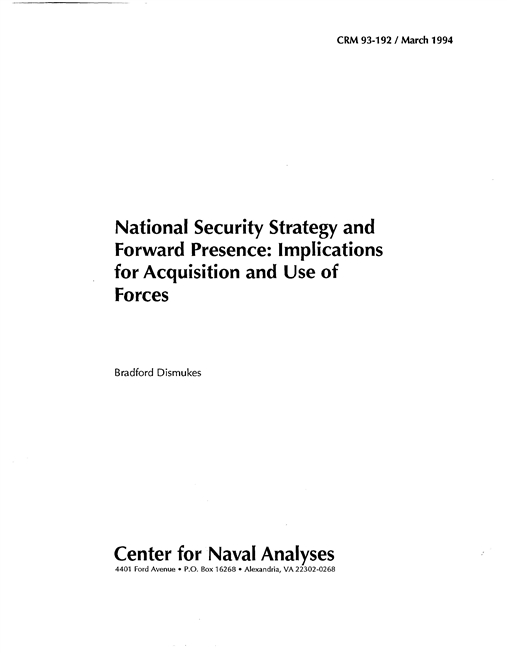The post-Cold War national security strategy engages U.S. power in all its forms to shape a more secure world. Overseas presence--operating forces forward to influence what foreign governments think and do is the most important and challenging of the tasks this strategy assigns the armed forces. This paper looks at the political and strategic case for presence and discusses some of its costs and risks. It draws conclusions about (1) what presence means in our use of the forces we have now and (2) what forces to buy for the future. It also suggests ways to make presence operations more efficient and issues deserving study in that regard.
The goal of the national strategy is a secure and prosperous nation in an increasingly democratic world. Today's security problems like nuclear proliferation and "regional bad actors" are serious, and the resulting instability that threatens U.S. interests and friends and allies must be dealt with, but the U.S. faces no mortal threat comparable to the one the USSR presented. Beyond the horizon, however, is the near certainty that, left to its own devices, the inherently flawed system of sovereign states will lead at least one of the major powers into an arms build-up, a regional arms race, hostile coalitions, and, finally, violent conflict on a growing scale. Because international organizations like the UN are not yet able to discipline a big power, the result, in perhaps a decade or more, will be a major direct threat to America.
The combination of no major threat either today or clearly emerging, coupled with certainty that one will develop in the long run, means the United States has the histaric opportunity and the fundamental need to shape events favorably well into the next century. The U.S. will want to do everything it can to make the UN effective, but global security rests on regional stability; geopolitics and economics dictate U.S. regional priorities.
U.S. strategy focuses on Europe, East Asia, and the Persian Gulf because, today or in the foreseeable future, only these regions have the combination of people, wealth, and technology to build armed forces that can pose a major threat. Thus, the U.S. has vital interests in the security order of these regions--interests for which the U.S. will fight a war. These interests are also vital because they are key to the growth of the world economy. World growth is vital to U.S. growth, 70 percent of which has come from trade since 1988. More importantly, it has also become a U.S. security interest. In the long run, the U.S. cannot be prosperous and secure unle theworld economy also grows.
The primary conditions for success are stable security structures in the key regions and collective action on behalf of stability. In the short run, stability is won though deterrence and military action; in the long run, by halting nuclear proliferation, foreclosing arms races, and strengthening patterns of regional cooperation. Collective action, which the American electorate demands whenever costs and risks are high, dictates that U.S. and allied forces be interoperable. Interoperability has become a strategic imperative. (Its requirements may contribute one basis on which to quantify the size and shape forces needed overseas.) Paradoxically, a capability for effective unilateral action, which the nation's commitments mandate independently, appears to be a requisite for success in coalition building and leadership.
Download reportApproved for distribution
Details
- Pages: 89
- Document Number: CRM 93-192
- Publication Date: 3/7/1994
